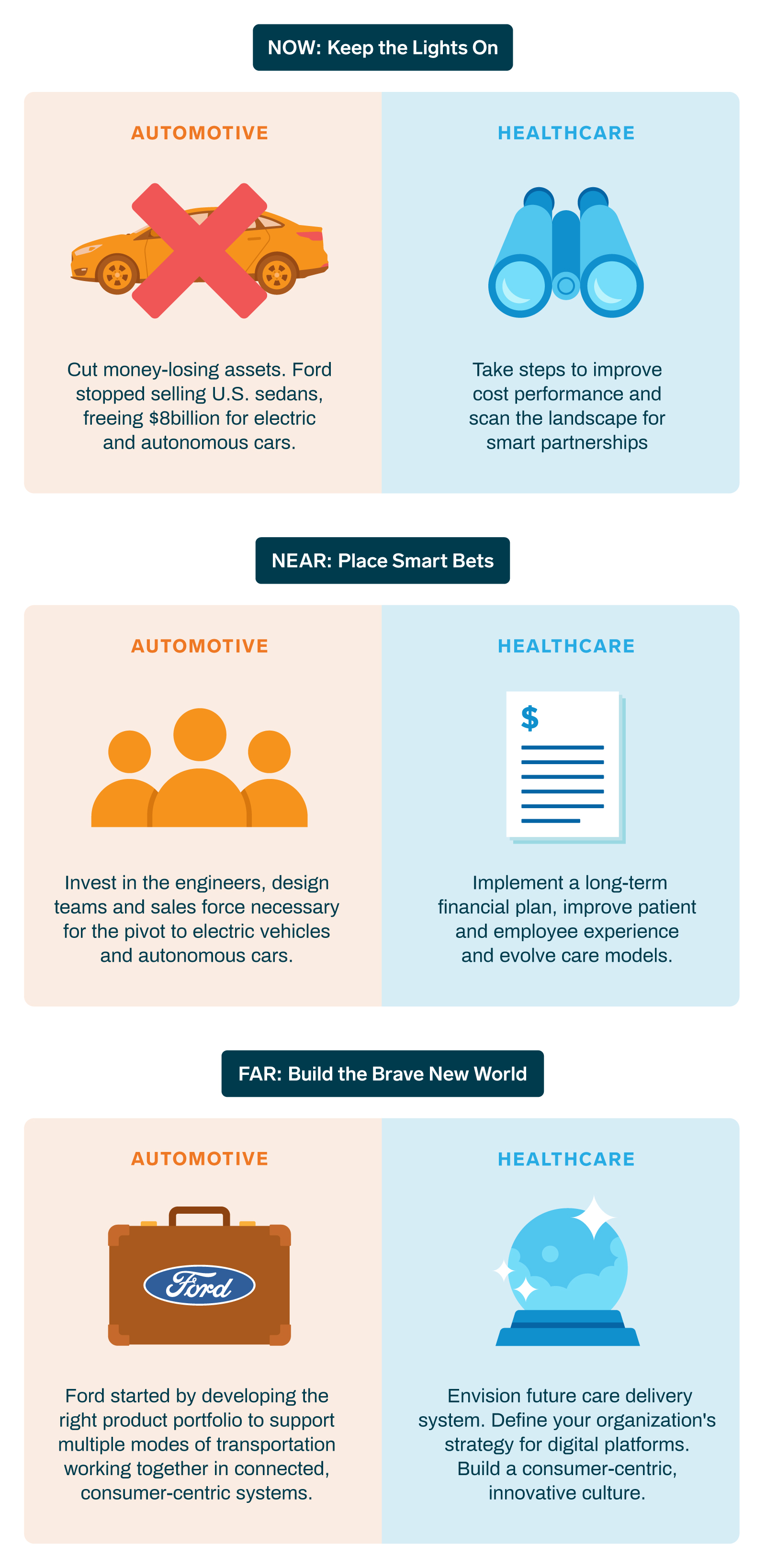
Built Ford Tough: Lessons Healthcare Execs Can Learn from Automakers
Advice for leading organizational change in the Internet economy, from Ken Kaufman, co-founder and Chair of Kaufman Hall
In 2017, Bill Ford realized his company needed to approach its role in the automotive industry completely differently. So Ford hired James Hackett, a new CEO, who brought a clear methodology to leading organizational change.

Kaufman
“He seems to be a top-shelf CEO and thinker,” says Kenneth Kaufman, founding partner and chair of Chicago-based consultancy Kaufman Hall. “But the changes he’s trying to make are so difficult that there’s no assurance he’ll be successful.”
Like the auto industry, healthcare is rife with legacy organizations that have been slow to change. Kaufman maintains that Hackett’s problem-solving framework can be useful to leaders looking to change their organizations in any industry – even healthcare.
Hackett’s method involves visualizing complex challenges by organizing them into a “now-near and far” framework that, though seemingly simple, truly resonates with people.
We sat down with Kaufman to talk about business in this age of the Internet Economy. Our conversation includes his unique framework and other insight on why legacy organizations struggle with vision and what healthcare leaders can learn from carmakers.
In your mind, what’s the best example of a legacy organization that successfully changed?
I don’t think we actually have many examples. Most of the economic change that has occurred over the past 25 years in America has come from organizations that were not in a position to change, but were on the outside, forcing change to happen.
Part of the reason is that, by and large, legacy organizations have had a really difficult time meeting the challenges of the tech and Internet economy.
What are the challenges of the tech and Internet economy?
In the old days, an organization could see new competition and take five years or so to assess how it was changing the market. If you look back, you can find examples over the last 50 years or so of organizations that did that in a pretty successful way.
But now, the speed-to-market of tech companies is unprecedented. Then, you add the radical changes that were imposed on the economy by technologies that are completely new.
The issue now, in any industry, is to try to challenge the disruption.
Why has healthcare historically been so bad at this?
The healthcare industry is very slow to change for some good reasons and for some not so good reasons. But, what we’re starting to see is a separation of two healthcare businesses in a way we haven’t seen before.
How so?
Healthcare grew up as an inpatient industry. For many legacy organizations it still is. But starting 15 years ago, the outpatient side started to pick up in a really significant way.
Ten years ago, 80 percent of hospital revenue was from inpatient care, and 20 percent of revenue was from outpatient care. Today, 40 percent of revenue is from inpatient care and 60 percent from outpatient care.
But what that did was create a bolt-on effect. You had organizations that still saw their business as inpatient business – they recognized the growth of outpatient work, but they forced the outpatient work through the inpatient chassis.
But now, organizations like United Healthcare, CVS and Aetna have never operated an inpatient bed and they have no intention of ever doing so. They see that as a mature, slow-growth or no-growth industry with bad pricing.
Competitively, that strategy could work – they’ll only be investing in and focusing on outpatient work, but the competition – the legacy healthcare organizations – will still have to compete on outpatient and inpatient. Our bet is that even large hospital organizations will struggle to do that.
Is there anything leaders at legacy hospital organizations could learn from other industries?
In 2017, Bill Ford thought the current pace of change at the company was not going to work. He needed an executive who was going to move faster but also with a completely different thought process.
Ford brought in James Hackett, whose mantra for change in the Internet economy is “now, near and far.”
 What does “now near and far” mean?
What does “now near and far” mean?
It’s a way ofvisualizing a very difficult problem that’s extremely hard to talk about. When you talk about it in these terms, it resonates. People relate to it.
It gives leaders a way to organize the different types of change they need to make. Take Ford. Hackett decided that in the “now,” the company had to do as well as it possibly could, because in order to prepare for a future where Ford makes electric cars and figures out the mobility industry, they were going to need a ton of cash. So the first thing Hackett did there was announce that Ford would no longer make the Taurus – which would save $8 billion dollars and give it the capital to develop electric cars and self-driving.
It seems hospitals really need to do that as well, in the “now.” They are not making very much money. They’re certainly not making the kinds of margins that corporate America thinks are necessary. So they need to think about new and different ways to deliver care in a more cost-effective way.
In the “near” term, leaders need to place educated bets on the future and begin to divert resources towards those bets.
Then of course, there’s this whole notion of “the far” – you’ve got to figure out what the far is. And believe me, in the Internet economy, there isn’t any way to describe how hard that is. As we’ve said in article after article, it’s not fair to make fun of the people who have failed because that presumes that you as an operator have a much better idea of how to succeed, and we haven’t seen that yet.
Coming up with the “far” is the biggest problem for legacy organizations – and figuring out how to execute on the re-visioning.
What is the risk legacy healthcare organizations run if they can’t separate change into now, near and far?
There are a lot of hospital CEOs who believe that delivering care is so hard that companies like CVS have no idea how to do it. They say they’ll wait and see if the CVS CEO can really deliver or whether he’s just got a lot of good ideas and a good PR firm.
But historically, that wait period can be fatal. Understandably, leaders want to wait to respond to disruption until the disruptors prove their power in the market. But by the time it’s proven, there’s nothing you can do about it. That’s the history of business in the age of the Internet.
What does it take for people to successfully lead organizational change?
I think it takes real leadership with a capital “L”. And it takes cultural change. And it takes the proper visioning process. But there are no guarantees.
